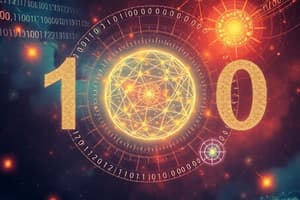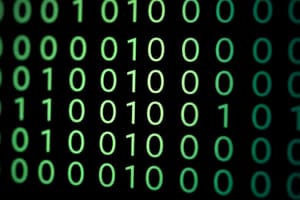Podcast
Questions and Answers
What is the decimal equivalent of the binary number 101101?
What is the decimal equivalent of the binary number 101101?
- 53
- 77
- 61
- 45 (correct)
Which of the following operations is essential when converting a binary number to its decimal equivalent?
Which of the following operations is essential when converting a binary number to its decimal equivalent?
- Multiplying each binary digit by its corresponding power of 2. (correct)
- Subtracting each binary digit from its corresponding power of 2.
- Dividing each binary digit by its corresponding power of 2.
- Finding the square root of each binary digit before multiplying it by a power of 2.
What is the decimal equivalent of the fractional binary number 10.011?
What is the decimal equivalent of the fractional binary number 10.011?
- 2.750
- 2.625
- 2.375 (correct)
- 2.500
What is the value of $2^{-5}$?
What is the value of $2^{-5}$?
Consider the binary number 101.101. How does the place value of the digit to the immediate left of the binary point compare to the place value to the immediate right of the binary point?
Consider the binary number 101.101. How does the place value of the digit to the immediate left of the binary point compare to the place value to the immediate right of the binary point?
Flashcards
What are Binary Numbers?
What are Binary Numbers?
Base 2 number system, uses only 0 and 1.
How to convert Binary to Decimal?
How to convert Binary to Decimal?
Multiply each digit by its corresponding power of 2 (starting from 2^0 on the right) and add the results.
Common Powers of 2
Common Powers of 2
2^0 = 1, 2^1 = 2, 2^2 = 4, 2^3 = 8, 2^4 = 16, 2^5 = 32, 2^6 = 64, 2^7 = 128, 2^8 = 256
Fractional Binary Numbers
Fractional Binary Numbers
Signup and view all the flashcards
Negative Powers of 2
Negative Powers of 2
Signup and view all the flashcards
Study Notes
Converting Binary to Decimal Numbers
- Binary numbers are base 2.
- Decimal numbers are base 10.
- Binary digits consist of 0 or 1.
Conversion Process
- The conversion process starts from the rightmost digit of the binary number.
- The rightmost digit is associated with 2^0.
- Move from right to left, associating each subsequent digit with an increasing power of 2 (2^1, 2^2, 2^3, etc.).
- Each binary digit is multiplied by its corresponding power of 2.
- Add the results, and this gets the decimal equivalent.
Example 1
- To convert the binary number 1010 to decimal:
- 0 * 2^0 = 0
- 1 * 2^1 = 2
- 0 * 2^2 = 0
- 1 * 2^3 = 8
- The decimal equivalent is: 8 + 0 + 2 + 0 = 10
Useful Powers of 2
- Using these values speeds up conversion
- 2^0 = 1
- 2^1 = 2
- 2^2 = 4
- 2^3 = 8
- 2^4 = 16
- 2^5 = 32
- 2^6 = 64
- 2^7 = 128
- 2^8 = 256
Example 2
- To convert the binary number 11011:
- 1 * 2^0 = 1
- 1 * 2^1 = 2
- 0 * 2^2 = 0
- 1 * 2^3 = 8
- 1 * 2^4 = 16
- The decimal equivalent is: 16 + 8 + 0 + 2 + 1 = 27
Converting Fractional Binary Numbers
- Numbers to the left of the decimal point use positive powers of 2 (2^0, 2^1, 2^2, etc.).
- Numbers to the right of the decimal point use negative powers of 2 (2^-1, 2^-2, 2^-3, etc.).
- 2^-1 = 1/2
- 2^-2 = 1/4
- 2^-3 = 1/8
Example of Fractional Conversion
- To convert the binary number 1100.101:
- 0 * 2^-3 = 0
- 0 * 2^-2 = 0.25
- 1 * 2^-1 = 0.5
- 0 * 2^0 = 0
- 0 * 2^1 = 0
- 1 * 2^2 = 4
- 1 * 2^3 = 8
Conversion of Negative Powers
- 2^-n is the same as 1 / 2^n
- For Example: 2^-4 = 1/16
Studying That Suits You
Use AI to generate personalized quizzes and flashcards to suit your learning preferences.
Description
Learn how to convert binary numbers to decimal numbers. This conversion involves multiplying each binary digit by powers of 2 and summing the results. Includes examples and a table of useful powers of 2.




